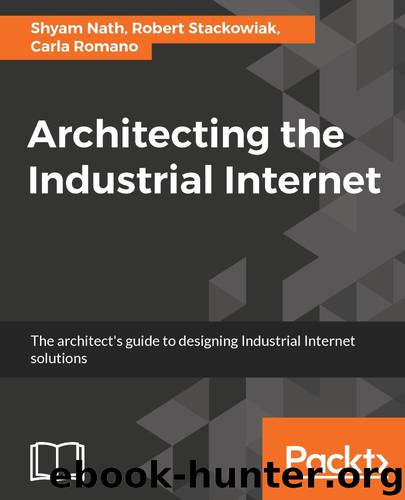Architecting the Industrial Internet: The architect's guide to designing Industrial Internet solutions by Shyam Nath & Robert Stackowiak & Carla Romano

Author:Shyam Nath & Robert Stackowiak & Carla Romano [Nath, Shyam]
Language: eng
Format: azw3
Tags: COM066000 - COMPUTERS / Enterprise Applications / Collaboration Software, COM048000 - COMPUTERS / Systems Architecture / Distributed Systems and Computing, COM091000 - COMPUTERS / Cloud Computing
Publisher: Packt Publishing
Published: 2017-09-22T04:00:00+00:00
The speed layer and field gateways
Earlier in this chapter, we pictured a speed layer in our architecture consisting of an IoT hub and/or event hub(s) serving as a cloud gateway and a streaming analytics engine. A cloud gateway is paired with a field gateway at the edge, or the cloud gateway will sometimes communicate directly with the smart devices themselves.
Some organizations deploy the speed layer on-premises instead of in the cloud to be located close to their existing batch layer systems. If transmission of data occurs to a central on-premises location, the gateway architecture would be similar, except an on-premises gateway would be pictured in our earlier diagram instead of the cloud gateway. This is especially common in organizations that built Industrial Internet solutions prior to public clouds gaining in popularity and the functionality required for these types of solutions.
Field gateways gather event data at the edge from smart devices and sensors. They are usually sized based on the number of data streams that will occur, the data collection rate (events/second), and the data storage duration desired. These gateways might be custom developed or provided by vendors. OSIsoft and ThingWorx are two such popular vendors deployed as part of many custom-built solutions.
Field gateways ingest messages, filter data, provide identity mapping, and log messages (for auditing purposes) as well as provide linkage to cloud or on-premises gateways. A newer trend has emerged to also perform stream analytics and machine learning within the field gateways. The ability to push these applications to the edge is now provided by some of the public cloud vendors. In a sense, this extends the speed layer to the edge. When these capabilities are deployed at the edge, you will need to consider CPU and memory sizing implications when sizing the field gateway platforms.
Within the speed layer that is deployed in a central location, the packaging of components varies among vendors. Among various public cloud vendors focused on IIoT solutions, the following functionality can be found in their offerings and/or those of their partners:
IoT hubs that enable device to cloud (D2C) via messaging protocols and cloud to device (C2D) communications contain information about the smart devices, support revocable access control for devices, enable operations modeling, and support message routing to event hubs or service buses
Event hubs without the management capabilities of the IoT hub, but specifically designed for just handling rapid message ingress with data transfer rates of up to 1 MB/second typical in cloud deployment
Streaming analytics engines providing a place to analyze data in motion with using machine learning algorithms or to view the current streaming data through business intelligence tools.
Download
This site does not store any files on its server. We only index and link to content provided by other sites. Please contact the content providers to delete copyright contents if any and email us, we'll remove relevant links or contents immediately.
Kotlin in Action by Dmitry Jemerov(17185)
Grails in Action by Glen Smith Peter Ledbrook(15390)
Sass and Compass in Action by Wynn Netherland Nathan Weizenbaum Chris Eppstein Brandon Mathis(13266)
Azure Containers Explained by Wesley Haakman & Richard Hooper(7499)
Configuring Windows Server Hybrid Advanced Services Exam Ref AZ-801 by Chris Gill(7497)
Running Windows Containers on AWS by Marcio Morales(7054)
Microsoft 365 Identity and Services Exam Guide MS-100 by Aaron Guilmette(5436)
Microsoft Cybersecurity Architect Exam Ref SC-100 by Dwayne Natwick(5272)
Combating Crime on the Dark Web by Nearchos Nearchou(5018)
The Ruby Workshop by Akshat Paul Peter Philips Dániel Szabó and Cheyne Wallace(4701)
Management Strategies for the Cloud Revolution: How Cloud Computing Is Transforming Business and Why You Can't Afford to Be Left Behind by Charles Babcock(4548)
Python for Security and Networking - Third Edition by José Manuel Ortega(4274)
The Age of Surveillance Capitalism by Shoshana Zuboff(4252)
Learn Wireshark by Lisa Bock(4176)
Learn Windows PowerShell in a Month of Lunches by Don Jones(4069)
The Ultimate Docker Container Book by Schenker Gabriel N.;(3920)
Ember.js in Action by Joachim Haagen Skeie(3661)
DevSecOps in Practice with VMware Tanzu by Parth Pandit & Robert Hardt(3612)
Windows Ransomware Detection and Protection by Marius Sandbu(3579)
